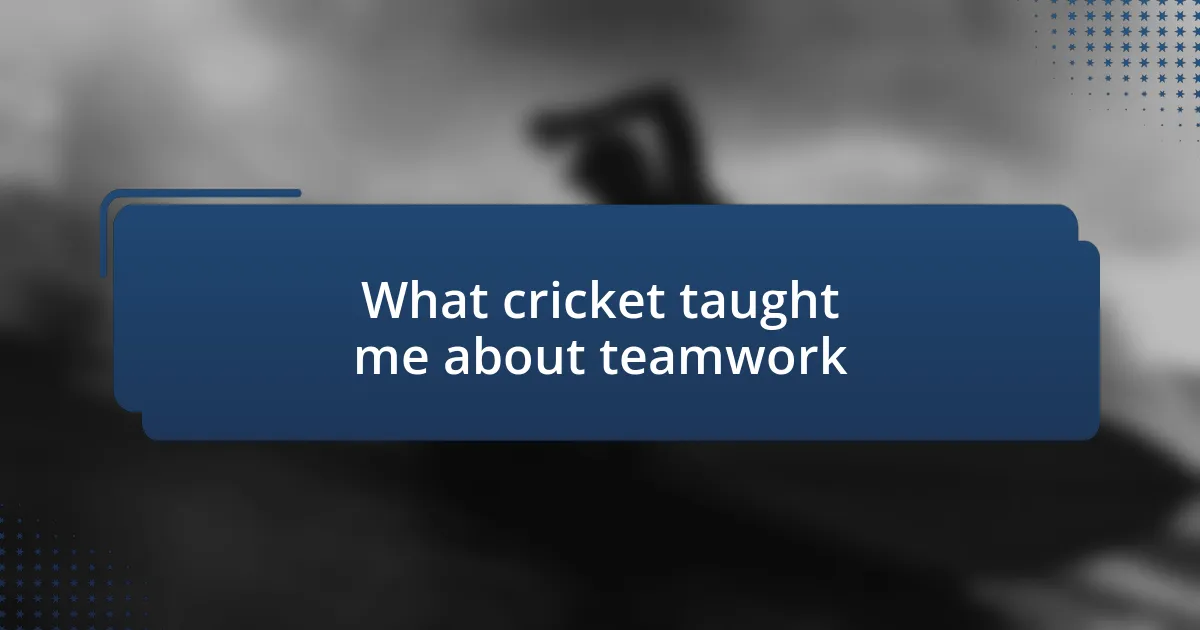Key takeaways:
- Preparation for my first cricket match involved intense mental rehearsals and understanding the game’s rules, which helped build my confidence.
- Selecting the right gear enhanced my performance, emphasizing the importance of comfort and safety in cricket equipment.
- Mental strategies such as visualization and positive self-talk were crucial in managing pre-match nerves and maintaining focus during the game.
- Reflecting on the match experience highlighted the significance of teamwork, resilience, and strategic planning in achieving success on the field.

Preparing for My First Match
The days leading up to my first match were a whirlwind of excitement and anxiety. I remember pacing around my room, mentally rehearsing every possible scenario. What if I stumbled while batting? Or missed a catch? These questions haunted me, yet they also fueled my determination to prepare.
I spent hours practicing in my backyard, my makeshift cricket pitch consisting of old mats and makeshift stumps. I specifically remember the first time I hit a clean shot; it felt like a small victory against my nerves. The sheer joy of connecting with the ball made me realize that preparation wasn’t solely about technique but also about building my confidence.
Gathering my gear felt like a ritual in itself. I laid out my kit meticulously, from my pads to my bat, each item carrying its meaning. As I checked off my checklist, I couldn’t help but feel a swell of pride and nervous anticipation. Would I live up to the expectations I had set for myself? With each item I packed, I felt more ready to take that leap into the thrilling world of cricket.

Understanding Cricket Rules
Understanding the rules of cricket can initially feel daunting, but they’re essential for enjoying the game. Each match is governed by a set of laws, primarily established by the International Cricket Council (ICC). I remember sitting down with a friend before my first match, going over the basic rules. We simplified everything to make it digestible, which helped ease my nerves when I finally stepped onto the pitch.
Cricket is played between two teams, each with eleven players. The game is divided into innings, where one team bats while the other bowls and fields. An important aspect to understand is how runs are scored. Hitting the ball and running between the wickets earns you runs, but there are also boundaries – four runs for the ball crossing the boundary on the ground, and six runs if it clears the boundary in the air. Reflecting on my first time seeing a ball sail over the boundary filled me with a mix of awe and desire; I wanted to experience that feeling.
Bowling, batting, and fielding are fundamental roles, and each has specific rules. For instance, a bowler can only deliver the ball from a specific point, and a valid delivery must not wind up as a no-ball or a wide. The fine line between a good delivery and a faulty one stuck with me during my early games, illustrating how attention to detail can determine the outcome of a match. When I bowled my first over, I felt a mix of fear and thrill, knowing how crucial it was to pitch the ball correctly.
| Aspect | Description |
|---|---|
| Innings | Two innings per match where teams alternate between batting and bowling. |
| Scoring Runs | Run by hitting the ball and running or by boundaries (4 or 6 runs). |
| No-ball/Wide | Invalid deliveries result in extra runs for the batting team. |
| Bowling Rules | Specific regulations dictate how the ball must be delivered. |

Choosing the Right Gear
Choosing the right gear can significantly impact your performance and confidence on the field. During my first match, I remember feeling overwhelmed by the different equipment options. I learned that selecting the right gear isn’t just about personal preference; it can enhance comfort and performance. Each piece serves a purpose, from protecting yourself to improving your play, and investing in quality gear pays off in the long run.
Here’s what you should consider when choosing your cricket gear:
- Bat: Look for one that feels comfortable and suits your playing style. I picked a bat that was slightly heavier, and though it took some getting used to, it gave me more power in my shots.
- Pads: Make sure they fit well to ensure protection without compromising mobility. My first pair was slightly too big, and I regretted it when I went to field.
- Gloves: Choose gloves that are breathable and provide a good grip on the bat. After using a subpar pair, I switched to more padded gloves, and it made a noticeable difference.
- Helmet: Prioritize safety with a well-fitted helmet that can withstand impacts. The first time I wore mine, it felt a bit cumbersome, but knowing it was protecting me eased my nerves.
- Shoes: Opt for shoes with good grip tailored for the type of pitch you’ll be playing on. I learned the hard way that wearing the wrong footwear can lead to slips that disrupt your game.
By focusing on these elements of gear selection, you’ll set yourself up for a successful and enjoyable cricket experience.

Mental Preparation Strategies
When it comes to mental preparation, I found that visualization played a crucial role in my performance. Before my first match, I would close my eyes and picture myself walking onto the field, hitting the ball, and even celebrating after a good shot. This practice not only calmed my nerves but also helped me build confidence. Have you ever tried to mentally rehearse a situation? It can create a sense of familiarity and reduce anxiety when the moment finally arrives.
Another strategy I discovered was the importance of positive self-talk. While warming up, I would remind myself of my training and past successes, telling myself that I was ready for this match. I vividly recall one moment when I felt a wave of doubt creep in, but I countered it with affirmations like, “You’ve worked hard for this!” It’s amazing how shifting your internal dialogue can transform your mindset and fuel your determination.
Lastly, grounding techniques became essential in managing pre-match jitters. During my first match, when the excitement turned to nervousness, I focused on my breathing—taking deep, slow breaths to anchor myself in the moment. Have you ever noticed how quickly your thoughts can spiral when you’re anxious? By controlling my breath, I was able to regain composure and concentrate on the game ahead. This practice not only helped that day but remains a go-to strategy for moments of high pressure.

Tips for On-field Performance
One of the key factors that enhanced my on-field performance was understanding my position and role within the team. During my first match, I recalled how pivotal it was for me to communicate effectively with my teammates. I asked questions like, “Where should I be positioned for optimal support?” This not only clarified my responsibilities but also fostered a sense of unity, proving that we were all in this together.
During the game, staying aware of the match’s dynamics was crucial. I remember vividly how I began to notice patterns in the opposing team’s strategy. When a batter consistently played defensively against spin bowling, I communicated this to my bowler. My keen observations helped contribute to a key wicket and reinforced the idea that alertness can often tip the scales in our favor.
Another tip that significantly impacted my performance was to embrace the energy of the crowd. Initially, I felt overwhelmed by the cheers and jeers, but then I learned to channel that energy into my gameplay. I remember converting anxious energy into excitement when I hit my first boundary, feeling the adrenaline surge through me. How do you react to the crowd during live matches? Learning to harness their energy positively can elevate your game and build an unbreakable connection between you and the spectators.

Learning from Match Experience
Experiencing my first match taught me that every moment is a learning opportunity. I distinctly remember my initial encounter with the pressure of chasing runs with limited overs left on the clock. It hit me: how I handled stress in that situation would shape my future performances. Reflecting on that moment, I realized the importance of maintaining composure—after all, isn’t it our ability to stay calm that often determines our success?
As I navigated through the highs and lows of the match, I also learned about resilience. There was a particular instance when I dropped an easy catch, and for a brief moment, I felt like the world was closing in on me. But instead of dwelling on my mistake, I made a conscious choice to bounce back. Wasn’t it fascinating how, by shifting my focus from failure to empowerment, I found the strength to contribute positively to the team? This experience reinforced for me that every setback could be a stepping stone for growth.
Another insight I took away from that day was the significance of teamwork and trust. When I saw my teammates rallying together after tough moments, it struck me how crucial support and belief in each other are. I vividly recall celebrating a crucial wicket together, a moment that forged bonds far beyond just cricket. Ask yourself: how often do you take time to celebrate collective achievements in sports? Acknowledging our team’s efforts can create an environment where everyone feels valued and motivated.

Reflecting on the Game Performance
Reflecting on my game performance, I found myself revisiting the moments that truly defined the match. For instance, there was a point where I struggled to find my rhythm at the crease. I remember feeling every eye on me, and the pressure made my mind race. Why did I let that get to me? It became clear that mental focus plays just as vital a role as physical skill in cricket.
Another aspect that struck me was the importance of strategy during the game. I recall a conversation with my captain right before we took the field, where we discussed our game plan. It was enlightening to realize that having a clear plan not only enhances individual performance but also shapes the entire team’s success. How often do we overlook the power of a well-thought-out strategy in high-pressure situations?
As I pondered over the match, I also felt a wave of gratitude for the experience itself. Each play, whether a success or failure, contributed to my understanding of the game. There was a sense of camaraderie that grew among us, and I came to appreciate how every player’s performance, good or bad, added a unique thread to the team’s story. Reflecting on these elements allowed me to see the game in a new light, revealing layers I hadn’t noticed initially.





